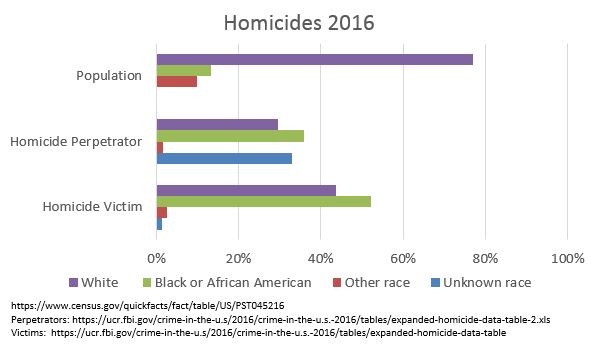The FBI just released data on homicides for 2016. In light of the various protests by the BLM and now football players, I thought I’d provide a a graph. It breaks out population, homicide perpetrators and homicide victims by race. (click to embiggen) Note… the number of offenders exceeds the number of victims. This is a result of some homicides involving multiple perpetrators. This can happen, for example, if both the shooter and the getaway driver in a drive-by shooting are charged with the crime. The race breakdown comes from the FBI, and the population comes from the Census. Data sources are shown in the graph itself. The key driver of the graph is the large percentage of perpetrators of unknown race. This happens because not all jurisdictions report
Topics:
Mike Kimel considers the following as important: Homicides, Uncategorized
This could be interesting, too:
tom writes The Ukraine war and Europe’s deepening march of folly
Stavros Mavroudeas writes CfP of Marxist Macroeconomic Modelling workgroup – 18th WAPE Forum, Istanbul August 6-8, 2025
Lars Pålsson Syll writes The pretence-of-knowledge syndrome
Dean Baker writes Crypto and Donald Trump’s strategic baseball card reserve
The FBI just released data on homicides for 2016. In light of the various protests by the BLM and now football players, I thought I’d provide a a graph. It breaks out population, homicide perpetrators and homicide victims by race.
(click to embiggen)
Note… the number of offenders exceeds the number of victims. This is a result of some homicides involving multiple perpetrators. This can happen, for example, if both the shooter and the getaway driver in a drive-by shooting are charged with the crime. The race breakdown comes from the FBI, and the population comes from the Census. Data sources are shown in the graph itself.
The key driver of the graph is the large percentage of perpetrators of unknown race. This happens because not all jurisdictions report on the race of offenders, but perhaps more importantly, because many crimes are not officially solved. I believe this is particularly true in urban areas with a lot of homicides where nobody wants to cooperate with the police. For example, through August of 2016, the clearance rate for homicides in Chicago was 21 percent. In Baltimore, its about a third. Nationally, its about two thirds.

